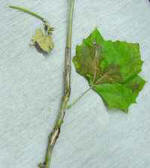 Adult
Japanese beetle control Adult
Japanese beetle control
Application of imidacloprid (Merit and other brand names) and
other systemic insecticides is effective in controlling Japanese
beetle adults. Although the imidacloprid occasionally doesn't
work in a tree to control this pest, it does over 80 percent of
the time. However, a soil application of imidacloprid typically
takes six to eight weeks to move completely up to the leaves of
large trees. With Japanese beetle emergence typically starting
the fourth week of June in our area, time is quickly passing to
achieve control in that manner. This would be a prime option for
linden trees, crab apples, rosebushes and other favorites of the
Japanese beetle.
Imidacloprid can be soil-applied either as a drench or by
injection. Because imidacloprid is easily tied up on organic
matter, any mulch and other dead organic matter must be removed
from around the base of the tree before a drench application is
made. Removal of turf around the tree would also be recommended
for a drench. Soil injections should be made deep enough to get
below mulch, turf thatch and other organic matter, but not
deeper than 3 to 4 inches. Apply to the soil within one to two
feet of the trunk, where the greatest concentration of fine
feeder roots is located.
Anthracnose and other leaf problems
 Anthracnose starts as dead leaf areas between leaf veins or
on the tips of leaves. When severe enough, leaves will fall. The
good news is that it rarely harms trees. If enough leaves drop,
a new set comes out in four to six weeks and we start all over.
The next set of leaves may also get the disease, but they may
not. Treatments when you see the symptoms of this disease are
simply wasted time and money. Anthracnose starts as dead leaf areas between leaf veins or
on the tips of leaves. When severe enough, leaves will fall. The
good news is that it rarely harms trees. If enough leaves drop,
a new set comes out in four to six weeks and we start all over.
The next set of leaves may also get the disease, but they may
not. Treatments when you see the symptoms of this disease are
simply wasted time and money.
Apple scab is a similar disease that can cause premature leaf
drop in apples and crab apples. The same scenario applies here.
If you are on a regular spray schedule for fruit trees, it
should prevent most of the problems. You could also spray crab
apples this way, but you would have to weigh the cost and
benefit since no fruit production is involved.
[to top of second column] |

Plum pockets is caused by a fungus on trees in the stone fruit
family. This would include mainly peaches and plums. It is rather
striking with the bright red swellings on the green leaves. This
disease can only be prevented with a dormant-time application of a
fungicide on your trees. Seeing it now means that you probably
should have sprayed before the buds began to swell (meaning before
leaves actually came out).
What's the end result? Trees get leaf diseases each year. Very
rarely are any trees killed by these problems, and those that die
are usually one foot in the grave to begin with. The only things
that help the trees at this point are fertilizing moderately and
watering during extended dry spells (which might be a while!). The
fertilizer helps trees cope with some of the lost energy from lost
leaves and the effort to put out a new set.
Mosquito reminder
The mosquito season has started in earnest. Of course mosquitoes
aren't pleasant to begin with, but throw in the West Nile virus, and
many people are rightly concerned about West Nile virus and how to
control mosquitoes. For now, if you are using a program in stagnant
water, with no fish, the wiggler stage is present and controls such
as the Bt israeliensis should be started. Also, continue to remove
development sites such as standing water, old tires and other
containers that hold water. The Bt israeliensis can be applied to
areas you can't drain, and it won't affect people, pets or
livestock.
[By
JOHN FULTON,
University of Illinois Extension, Logan County]
 |